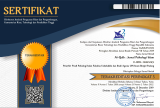Psychological Preparedness for Disaster in Terms of Self Efficacy and Religious Coping
Abstract
Abstract: This study aim to determine level of psychological preparedness for disaster in terms of self efficacy and religious coping. Subjects in this study were 400 people of Daerah Istimewa Yogyakarta province obtained using convenience sampling techniques. This data were collected by psychological preparedness for disaster scale with an alpha coefficient of 0,929, self efficacy scale with an alpha coefficient of 0,852, and religious coping scale with an alpha coefficient of 0,917. The result showing that : 1) there was a significant relationship between self efficacy and religious coping with psychological preparedness for disaster with a significance of 0,000 (p<0,05), with an effective contribution of 43,3% on psychological preparedness for disaster, 2) there was a positive relationship between self efficacy with psychological preparedness for disaster, with an effective contribution of 38,8% on psychological preparedness for disaster, and 3) there was a positive relationship between religious coping with psychological preparedness for disaster, with an effective contribution of 4,5% on psychological preparedness for disaster. Then, based on this research, there was a relationship between self efficacy and religious coping with psychological preparedness for disaster.
Keywords
Full Text:
PDFReferences
Aflakseir, A., & Mahdiyar, M. (2016). The role of religious coping strategies in predicting depression among a sample of women with fertility problems in Shiraz. Journal of Reproduction and Infertility, 17(2), 117–122.
Angganantyo, W. (2014). Coping Religious pada Karyawan Muslim ditinjau dari Tipe Kepribadian. Jipt, 02(01), 50–61.
Boylan, J. (2016). The Development and Validation of the Bushfire Psychological Preparedness Scale (BPPS). 1–260.
CNNIndonesia. (2019). BNPB Catat 3.768 Bencana dan 478 Meninggal Sepanjang 2019.
https://www.cnnindonesia.com/nasion al/20191230190943-20-461135/bnpb-
catat-3768-bencana-dan-478- meninggal-sepanjang-2019
Etikan, I. (2016). Comparison of Convenience Sampling and Purposive Sampling. American Journal of Theoretical and Applied Statistics, 5(1), 1. https://doi.org/10.11648/j.ajtas.20160 501.11
Every, D., McLennan, J., Reynolds, A., & Trigg, J. (2019). Australian
householders’ psychological preparedness for potential natural hazard threats: An exploration of contributing factors. International Journal of Disaster Risk Reduction, 38(October 2018), 101203. https://doi.org/10.1016/j.ijdrr.2019.10 1203
Flin, D. (2001). Coping with fire. Nuclear Engineering International, 46(561), 16. https://doi.org/10.1201/97814200317 51.ch10
Grant, C. (2018). Disaster preparedness to reduce anxiety and post-disaster stress. K4D Helpdesk Report, 1–13.
https://assets.publishing.service.gov.uk/media/5c6bd4bae5274a72bac384e9/501_Disaster_Preparedness_for_Reduce_Anxiety_and Post-Disaster_Stress.pdf
Herdwiyanti, F., & Sudaryono. (2012). Perbedaan Kesiapsiagaan Menghadapi Bencana Ditinjau dari Tingkat Self- Efficacy pada Anak Usia Sekolah Dasar di Daerah Dampak Bencana Gunung Kelud. Jurnal Psikologi Kepribadian Dan Sosial, 1(03), 136–141. http://journal.unair.ac.id/download- fullpapers-jpks957e6ca3132full.pdf
LIPI-UNESCO/ISDR. (2006). Kajian Kesiapsiagaan Masyarakat dalam Mengantisipasi Bencana Gempabumi dan Tsunami. 579. http://www.buku- e.lipi.go.id/utama.cgi?lihatarsip&jans 001&1273262299&51
Malkina-pykh, I. G. (2013). An integrated model of psychological preparedness for threat and impacts of climate change disasters. July, 121–133.
Mareta, N. (2018). Pengetahuan dan Manajemen Bencana. Mareta, Nandian, 1 (March 2014), 14. https://doi.org/10.13140/RG.2.2.2819 6.94089
Morrissey, S. a, & Reser, J. P. (2003). Evaluating the effectiveness of psychological preparedness advice in community cyclone preparedness materials. The Australian Journal of Emergency Management, 18(2), 46–61.
Octarina, M., & Afiatin, T. (2013). Efektivitas Pelatihan Koping Religius Untuk Meningkatkan Resiliensi Pada Perempuan Penyintas Erupsi Merapi. Jurnal Intervensi Psikologi (JIP), 5(1), 95–110.
https://doi.org/10.20885/intervensipsi kologi.vol5.iss1.art6
Rohmi, F. (2016). Psychological Preparedness Masyarakat di Daerah Rawan Bencana Banjir Desa Sitiarjo Sumbermanjing Wetan. E-Journal UMM, 7, 88–93. https://ejournal.umm.ac.id/index.php/keperawatan/login?source=%2Findex.php%2Fkeperawatan%2Fissue%2Fview
Safaria, T. (2011). Peran Religious Coping Sebagai Moderator Dari Job Insecurity Terhadap Stres Kerja Pada Staf Akademik. HUMANITAS: Indonesian Psychological Journal, 8(2), 155. https://doi.org/10.26555/humanitas.v8 i2.462
Sanger, A. S. C., & Indra Nurpatria, N. (2019). Comparing Men’s and Women’s Psychological Preparedness in Cangkringan for Mount Merapi Volcanic Eruptions. KnE Life Sciences, 4(10),311. https://doi.org/10.18502/kls.v4i10.373 4
Utami, M. S. (2012). Religiusitas , Koping Religius , dan. Psikologi, 39(1), 46–66.
Zulch, H. (2019). Psychological preparedness for natural hazards – improving disaster preparedness policy and practice. Griffith University School of Psychology Revue, Gar 2019, 1–43. https://www.unisdr.org/we/inform/publications/66345
Refbacks
- There are currently no refbacks.
Ruang Jurnal,
Fakultas Ushuluddin dan Studi Agama,
UIN Imam Bonjol Padang
Jl. Mahmud Yunus No.6,Lubuk Lintah,
Kota Padang, Sumatra Barat
E-mail: jurnal-alqalb@uinib.ac.id

This work is licensed under a Creative Commons Attribution-ShareAlike 4.0 International License.



